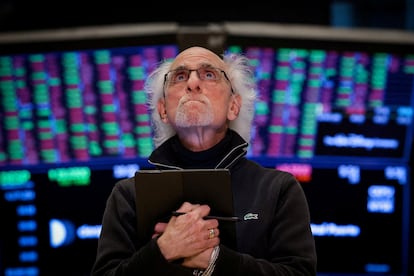The five red flags that show the worst may not be over in the markets
Investors are waiting anxiously for possible deals to end the tariff war, without losing sight of the growing signs of stress. Fears of a recession have triggered the biggest stock market falls since the pandemic


With just hours to go before the entry into force of the so-called reciprocal tariffs, investors parked their sell-offs on Tuesday and attempted a rebound. Analysts insist on caution (technical bounces are common in bear markets) and warn that the worst may not yet be over. A full-scale tariff war, with risks to inflation and growth, is seen as a worst-case scenario for economies and stock markets. But beyond macro figures or negotiations, markets are showing signs of stress. These are the points to watch for in the coming weeks.
Lower prices of gold and bonds
After a start to the year in which gold asserted its role as a safe-haven asset, rising more than 20% and setting one record after another, in the last few days correction has prevailed. From the highs of $3,134.7 per ounce, prices have fallen by 4%. A similar movement has been experienced by U.S. ten-year bonds, which on Monday marked the biggest rise in yield in two and a half years, 18 basis points up to 4.21% (yield moves inversely to price). These declines do not mean that the risk of recession has disappeared or that the market is abandoning its preference for safe assets. They are actually the result of market stress: investors, mainly hedge funds, are selling assets hand over fist because they need immediate liquidity, either to hedge bets in other areas of the market, to provide collateral in leveraged transactions, or to reduce their own indebtedness.
Highest volatility since the pandemic
With investors trying to decipher the impact of trade measures, market volatility has spiked. The performance of equities on Monday was a good illustration of this: that day, Donald Trump again threatened China with an additional 50% tariff, and unfounded rumors of a 90-day extension to the implementation of reciprocal tariffs momentarily triggered markets. The Vix index, also known as the fear index, chained its third session of strong rises. This indicator reflects the cost to investors of protecting themselves from stock market falls through the options market: the higher it rises, the more expensive this protection becomes, because sellers demand more money.
In line with the performance of the stock markets, the Vix index fell on Tuesday from the highs of recent days and dropped to 43 points, some distance from the 50 points it had reached Monday at intraday levels, highs not seen since the outbreak of the pandemic. Since the low of 17 points at the end of March, the indicator has risen by 168%. Current volatility levels are comparable to those seen at the time of the Covid outbreak and the financial crisis triggered by the collapse of Lehman Brothers, when the indicator rose to an all-time high of 80.56 points. The Vix index is a very reliable indicator of investors’ current level of risk aversion, although it cannot predict the future.
Massive sell-off of high-risk debt
In recent days the high quality debt market, and especially government bonds, have played a diversifying role as a safe haven asset. But not all bonds are equal. High-yield debt, which is not investment grade in the eyes of rating agencies and is also known as junk bonds, has seen the biggest sell-off since 2020. The additional yield demanded by investors for this kind of debt has risen 100 basis points in the last two sessions and is now around 4.45%, the highest level since November 2023. This is another unmistakable sign of concern among investors about the eventual slowdown in the U.S. economy.
David Ardura, investment director of Finaccess Value, says that anything that implies lower growth is a problem for companies with a lot of debt on their balance sheets. To this, Ardura adds the excessive optimism that existed in the market. “The perception of risk was residual,” he acknowledges. Before the tariff offensive materialized, the expert notes, the complacency of the equity and bond market was very high, which had led to high-yield bond spreads dropping to 2007 lows. At the beginning of the year, the consensus was that growth would remain stable, inflation would continue to come down and technical indicators would remain solid. But these forecasts were blown out of the water on April 2. Protectionist measures, the strongest since the Great Depression, have changed perceptions and the fear of stagflation is once again resonating strongly among investors and managers.
Risk of default rises to 8%
It is still too early to quantify the impact of the tariffs, but rating firms are starting to make their calculations on the risk of corporate defaults. Moody’s reckons that the economic slowdown could push the default rate on subprime debt to 8% within a year, up from 5% today but still below the record 9.7% when the dotcom bubble burst. And it is the trade war that is likely to trigger the next wave of corporate defaults: Bloomberg reported that more than $43 billion in bonds and loans have been tipped into distress, the highest growth in 15 months. Investors are reviewing the companies that could be affected as they assess the impact on consumer spending.
Some of the sectors that could face the greatest difficulties include retail, energy, home building products and automakers that are still recovering from supply chain disruptions, according to Moody’s. The current situation could also make it more difficult for the most leveraged companies to refinance their debt, due to widening spreads. Although expectations of rate cuts in the U.S. have risen sharply in recent days, experts warn that the debate is premature.
Risk premiums no longer at annual lows
As investors have been shedding equities, they have increased the rotation towards safer assets, a move within which peripheral risk premiums, such as those of Spain and Italy, have left their yearly lows behind. In an uncertain environment, investors are once again favoring German bonds, even under the fiscal expansion plan announced by Friederich Merz, which is seen as an economic lifeline for the European Union. Investors have recognized this: in addition to the strong stock market rises recorded in March, they have been buying German bonds in recent days.
With debt that is maturing in 2035 falling from the 3% highs it reached a month ago, the spread with the Spanish benchmark is above 70 basis points, compared to the 60 it reached last January, when demand for Spanish securities was at a record high. Meanwhile, Italy’s country risk has risen from 109 points to the current 122. Despite these increases, analysts point out that the situation of the European periphery is far from what was experienced during the years of the debt crisis. The higher economic growth experienced by countries such as Italy and Spain has made it possible to redress economic imbalances. The rapid movement in spreads is not the result of particular aspects of the two countries, but rather of the tendency of the market as a whole to seek safe havens.
Sign up for our weekly newsletter to get more English-language news coverage from EL PAÍS USA Edition
Tu suscripción se está usando en otro dispositivo
¿Quieres añadir otro usuario a tu suscripción?
Si continúas leyendo en este dispositivo, no se podrá leer en el otro.
FlechaTu suscripción se está usando en otro dispositivo y solo puedes acceder a EL PAÍS desde un dispositivo a la vez.
Si quieres compartir tu cuenta, cambia tu suscripción a la modalidad Premium, así podrás añadir otro usuario. Cada uno accederá con su propia cuenta de email, lo que os permitirá personalizar vuestra experiencia en EL PAÍS.
¿Tienes una suscripción de empresa? Accede aquí para contratar más cuentas.
En el caso de no saber quién está usando tu cuenta, te recomendamos cambiar tu contraseña aquí.
Si decides continuar compartiendo tu cuenta, este mensaje se mostrará en tu dispositivo y en el de la otra persona que está usando tu cuenta de forma indefinida, afectando a tu experiencia de lectura. Puedes consultar aquí los términos y condiciones de la suscripción digital.

